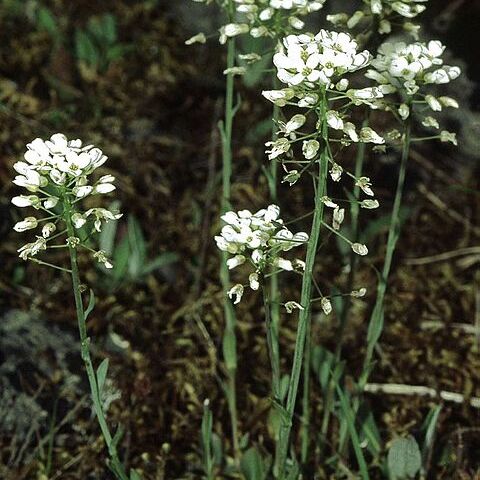Plants often fetid when crushed; not scapose; glabrous or pubescent. Stems erect, unbranched or branched distally. Leaves basal and cauline; petiolate or sessile [subsessile]; basal (often withered in fruit), rosulate or not, petiolate [subsessile], margins entire, repand, dentate, or sinuate-dentate; cauline sessile, blade (base auriculate or sagittate), margins dentate, repand, or entire. Racemes (several-flowered), considerably elongated in fruit. Fruiting pedicels divaricate, (straight or slightly curved), slender. Flowers: sepals erect or ascending, ovate or oblong, (margins membranous); petals spatulate [oblong], claw differentiated or not from blade, (apex obtuse or emarginate); stamens slightly tetradynamous; filaments not dilated basally; anthers ovate, (apex obtuse); nectar glands (2 or 4), lateral, often 1 on each side of lateral stamen, median glands absent. Fruits silicles, sessile, oblong, obovate, obcordate, or suborbicular, (apex often notched), keeled, strongly angustiseptate; valves winged throughout or apically, glabrous; replum rounded; septum complete, (not veined); ovules 6-16 per ovary; style obsolete or not, (included in apical notch); stigma capitate. Seeds plump, not winged, ovoid; seed coat (coarsely reticulate, alveolate or concentrically striate), not mucilaginous when wetted; cotyledons accumbent. x = 7.
Annual to perennial hapaxanthic herbs, glabrous or rarely with simple hairs. Leaves undivided, ± clasping. Racemes terminal, ebracteate, with numerous small flowers. Sepals erect to ascending, not saccate. Petals white or ± violet, rarely yellow, spathulate or shortly clawed. Stamens 6, indistinctly tetradynamous; filaments linear, not appendiculate; anthers ovoid, obtuse. Nectaries usually as 2 hemispherical ± prolonged glands at each side of the base of each lateral stamen; median nectaries absent. Ovary obovoid to ellipsoid, with 2–many ovules. Fruit a silicula, dehiscent, ± dorso-ventrally compressed, with narrow septum, ± broadly obovate to obtriangular in outline, often emarginate; valves keeled, often winged; stigma capitate, ± bilobate. Seeds ellipsoid, somewhat compressed, wingless, ± mucilaginous.
Annual to perennial taprooted herbs. Hairs simple or 0. Stems procumbent to erect, leafy. Lvs simple, the upper amplexicaul. Racemes ebracteate. Sepals erect or spreading, not saccate. Petals white to purple. Stamens 6, without appendages. Lateral nectaries 4, paired beside bases of lateral stamens; median nectaries 0. Silicle obcordate, angustiseptate, dehiscent; valves keeled and usually winged, sometimes the wings extended to form an apical notch to the silicle. Style long or short; stigma capitate to somewhat 2-lobed. Seeds ovoid, not winged, 1-8 per locule.
Sep ascending; pet white (in ours) to pink or blue, spatulate to obovate; short filaments flanked on each side by a semicircular gland; filaments slender, with ovate anthers; ovary ellipsoid to obovoid, somewhat flattened; style very short; frs orbicular to obovate or obcordate, strongly flattened contrary to the septum, distended over the seeds, keeled or winged at the margin, retuse at the summit; seeds normally 4 or more per locule; herbs, usually glabrous, with auriculate lvs. 75, mostly Eurasia.
Annual herbs. Inflorescence ebracteate. Sepals erect, equal, non-saccate. Petals clawed. Stamens 6. Nectariferous glands 4, one either side of lateral stamens. Stigma capitate, somewhat bilobed. Silicula dehiscent; septum narrow; valves notched at apex and including style, flattened, winged. Seeds 5–8 per locule; radicle accumbent.

